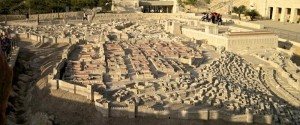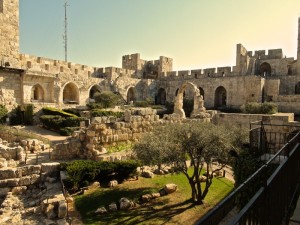Witness of the Stones
Besides the gospel stories, do other sources shed light on the events of Jesus’ Passion?
Jerusalem itself, where Jesus’ Passion took place, is a likely place to look. What makes our search difficult, however, is the almost complete devastation the city suffered in the Roman siege that leveled most of its walls and buildings during the Jewish revolt in 70 A.D.. With brutal thoroughness, the legions of the Roman general Titus destroyed the city, killing or enslaving its inhabitants. Some of the fiercest fighting took place around the traditional place of Calvary. The city was completely rebuilt by the Emperor Hadrian in the late second century.
After the Roman period, Persian, Moslem, and Crusader armies swept through the Holy Land, destroying or rebuilding on the sacred sites. For almost two thousand years, the land has suffered more than its share of wars, earthquakes and other natural disasters. The city is hardly a place one expects to find traces of the past.
Yet traces remain.
Jerusalem Rebuilt by Hadrian
After a second Jewish revolt in 135 A.D. the Emperor Hadrian sought to obliterate all trace of the ancient city by completely rebuilding Jerusalem as a Roman city, using the plan followed by Roman builders for constructing a colony. The plan resulted in a city smaller in size than before, which can still be seen in the street-plan of present-day Jerusalem. Renaming it “Aelia Capitolina”, Hadrian repopulated his new city with foreign colonists and prohibited Jews from entering the city under pain of death. Statues of Roman gods and goddesses replaced sacred Jewish sites. Little remained, at least visibly, of Jerusalem’s Jewish past except the desolate foundation of the temple.
The Jewish-Christian Community
Even so, there’s evidence that a small Jewish-Christian community continued to meet on Mount Sion in the southern outskirts of the city, though its activities were restricted. They cherished certain sites associated with the memory of Jesus: a cave at Bethlehem marking his birth, a cave near the summit of Mount of Olives marking his last teachings to his disciples and his ascension, and the site of his death and resurrection which they located alongside the forum in Hadrian’s new city, where the Romans had raised a statue of Venus. Their recollections helped later generations identify key sites from the past.
 Constantine’s Jerusalem
Constantine’s Jerusalem
The face of Jerusalem dramatically changed when the Emperor Constantine began a era of favor toward the Christian church in 313 A.D. Constantine initially built three basilicas on the ancient Christian locations pointed out by tradition: Calvary, the Mount of Olives and Bethlehem. As Christians flocked to the Holy City these locations became the principal sites of liturgical life for Jerusalem’s growing Christian church, which influenced Christian liturgical practices and devotion throughout the world.
From the 4th to the 7th century, the Holy Land became a Christian land, a land of pilgrims, a great visual bible. Almost 500 Christian churches and shrines were built, many over places thought to commemorate incidents in the Old or New Testaments. One recognizes, however, that many sites were chosen overzealously. Scholars like St. Jerome (+ 420), a long term resident in Bethlehem, complained that the “monstratores”, the guides, multiplied places and relics to satisfy eager pilgrims craving to touch and see the places mentioned in the bible.
Recent Studies of the Holy Land
In recent years archaeologists and historians have studied the Holy Land and offer a clearer picture of its history and ancient culture. Visitors to the holy places today can see the results of their work in the model of the Jerusalem from the time of Jesus at the Jewish Museum in Jerusalem, for example. (Above) The “monstratores” of St. Jerome’s time have been replaced by reliable guides and guidebooks like “The Holy Land: An Oxford Archeological Guide,” by Jerome Murphy-O’Connor, OP. New York 2008.
The menu to the right will guide you through the important places that are witnesses in stone to the Passion of Jesus Christ.

